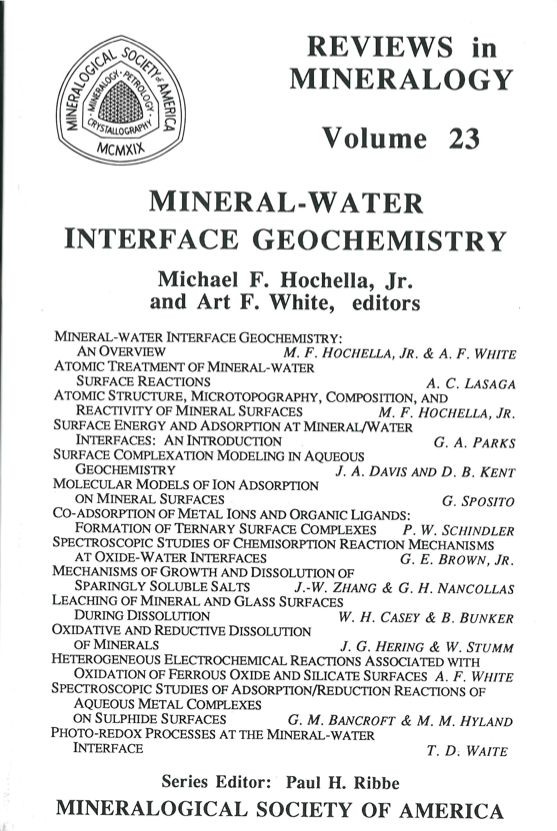
Mineralogical Society of America, Founded December 30, 1919
Order Publications Online (25% discount for MSA, CMS and GS members, except shipping)
MinPubs.org Pay-Per-View GeoScienceWorld Pay-Per-View

1990, i-xvi + 603 pages. ISBN 0-939950-28-6; ISBN13 978-0-939950-28-7
This book and accompanying MSA short course was first considered in 1987 in response to what seemed to be a growing interest in the chemical reactions that take place at mineral-water interfaces. Now, in 1990, this area of work is firmly established as one of the major directions in mineralogical and geochemical research (see Chapter 1). We believe that there are two major reasons for this. The first is that there is a growing awareness within various earth science disciplines that interface chemistry is very important in many natural processes, i.e., these processes cannot be adequately described, much less understood, unless the role of interface chemistry is carefully considered. Perhaps the best illustration of this increase in awareness is the diverse backgrounds of the scientists who will be attending the short course. Participants have research interests in aqueous and environmental geochemistry, mineralogy, petrology, and crystallography. In the final list of participants, one-quarter are from outside the United States, and include scientists from Australia, Canada, England, France, Israel, The Netherlands, Sweden, and Switzerland.
The second reason that this field is one of the major new research directions in the earth sciences is because many methods, both experimental and theoretical, have relatively recently become available to study mineral surfaces and mineral-water interfaces. Many important spectroscopic techniques now used routinely to characterize surfaces and interfaces were not available twenty years ago, and some were not available just five years ago. To emphasize the importance of these methods, two Nobel prizes were awarded in the 1980's to the developers of x-ray photoelectron spectroscopy (XPS) and scanning tunneling microscopy (STM).
We have directed ourselves and the other authors of this book to follow the general guidelines of writing for "Reviews in Mineralogy". However, for the subject of mineral-water interface geochemistry, this is not easy because the field is far from mature. Several chapters are not reviews in the traditional sense in that they cover research that is relatively recent for which a considerable amount of work remains. In any case, we believe that this book describes most of the important concepts and contributions that have driven mineral-water interface geochemistry to its present state. We begin in Chapter 1 with examples of the global importance of mineral-water interface reactions and a brief review of the contents of the entire book. Thereafter, we have divided the book into four sections, including atomistic approaches (Chapters 2- 3), adsorption (Chapters 4-8), precipitation and dissolution (Chapters 9-11), and oxidation-reduction reactions (Chapters 11-14).
Michael F. Hochella, Jr., Stanford, California, USA
Art F. White, Menlo Park, California, USA
September 1, 1990
Title Page
p. i
Copyright
p. ii
Dedication
p. iii
Foreword, Preface & Acknowledgements
p. iv - v
Table of Contents
p. vi - xvi
Chapter 1. Mineral-water Interface Geochemistry: An Overview
by Michael F. Hochella, Jr. and Art F. White, p. 1 - 16
Chapter 2. Atomic Treatment of Mineral-water Surface Reactions
by Antonio C. Lasaga, p. 17 - 86
Chapter 3. Atomic Structure, Microtopography, Composition, and Reactivity of Mineral Surfaces
by Michael F. Hochella, Jr., p. 87 - 132
Chapter 4. Surface Energy and Adsorption at Mineral/Water Interfaces: An Introduction
by George A. Parks, p. 133 - 176
Chapter 5. Surface Complexation Modeling in Aqueous Geochemistry
by James A. Davis and Douglas B. Kent, p. 177 - 260
Chapter 6. Molecular Models of Ion Adsorption on Mineral Surfaces
by Garrison Sposito, p. 261 - 280
Chapter 7. Co-adsorption of Metal Ions and Organic Ligands: Formation of Ternary Surface Complexes
by Paul W. Schindler, p. 281 - 308
Chapter 8. Spectroscopic Studies of Chemisorption Reaction Mechanisms at Oxide-Water Interfaces
by Gordon E. Brown, Jr., p. 309 - 364
Chapter 9. Mechanisms of Growth and Dissolution of Sparingly Soluble Salts
by Jing-Wu Zhang and George H. Nancollas, p. 365 - 396
Chapter 10. Leaching of Mineral and Glass Surfaces During Dissolution
by William H. Casey and Bruce Bunker, p. 397 - 426
Chapter 11. Oxidative and Reductive Dissolution of Minerals
by Janet G. Hering and Werner Stummv. p. 427 - 466
Chapter 12. Heterogeneous Electrochemical Reactions Associated with Oxidation of Ferrous Oxide and Silicate Surfaces
by Art F. White, p. 467 - 510
Chapter 13. Spectroscopic Studies of Adsorption/Reduction Reactions of Aqueous Metal Complexes on Sulphide Surfaces
by G. Michael Bancroft and Margaret M. Hyland, p. 511 - 558
Chapter 14. Photo-redox Processes at the Mineral-water Interface
by T. David Waite, p. 559 - 603